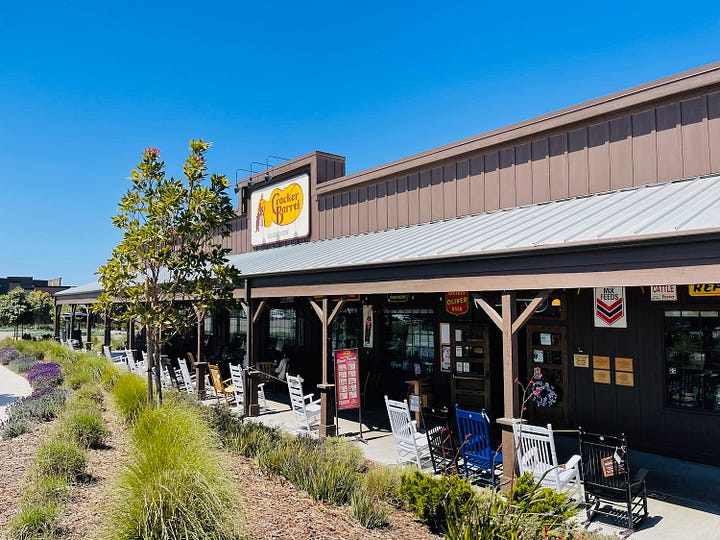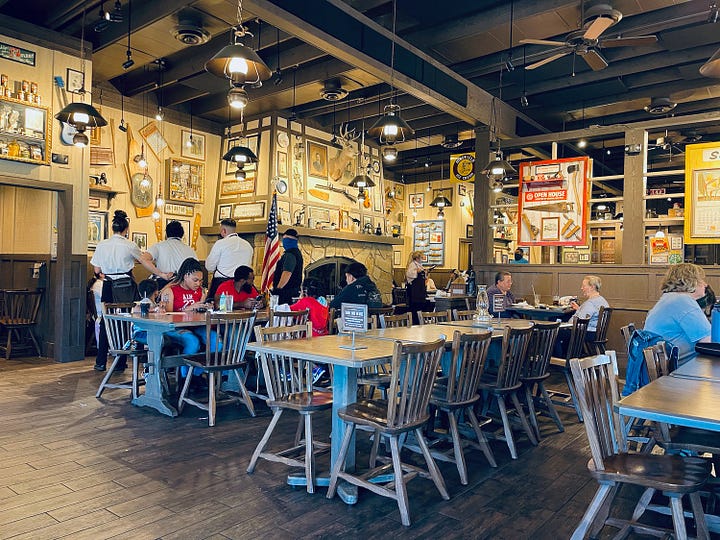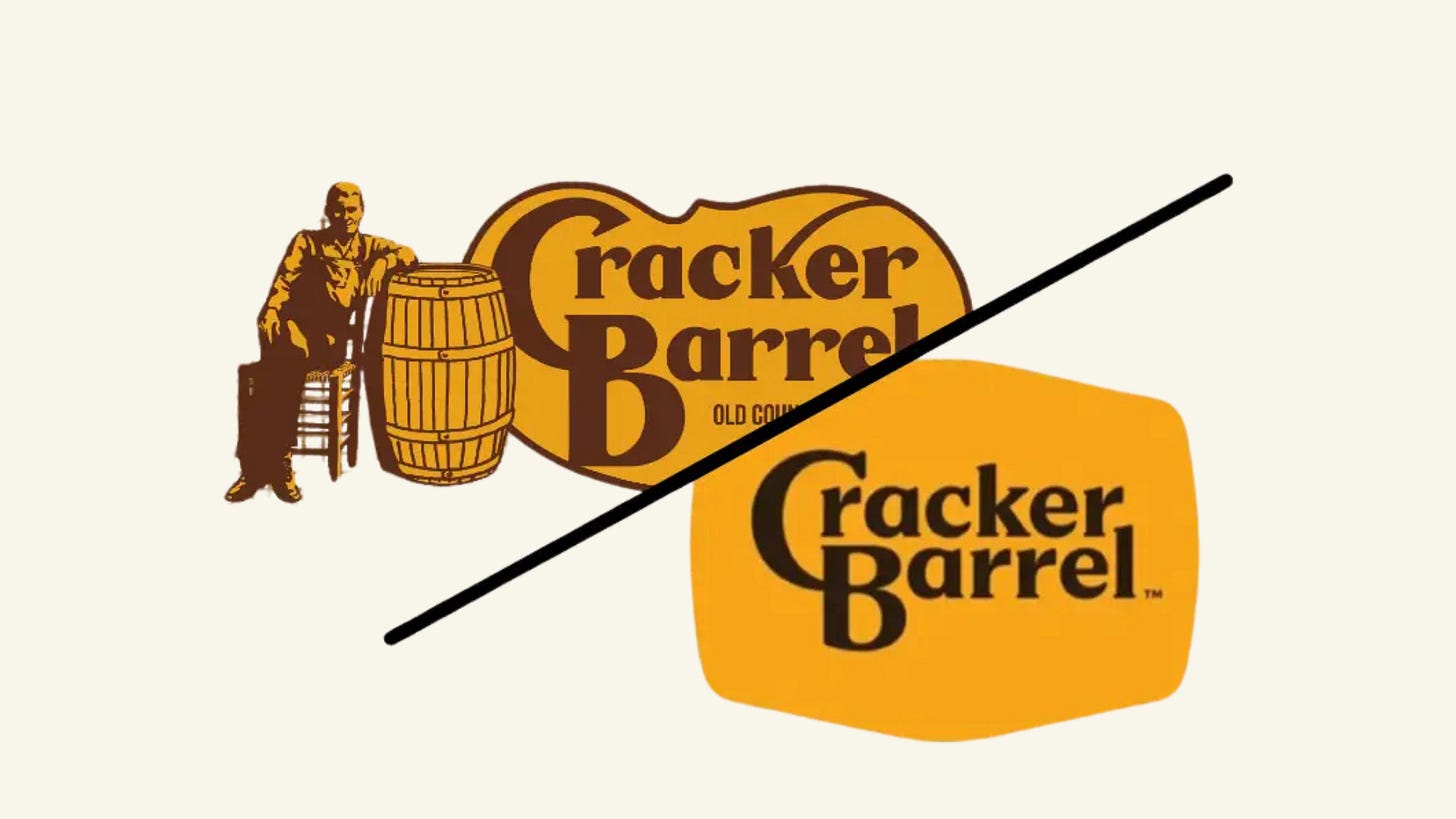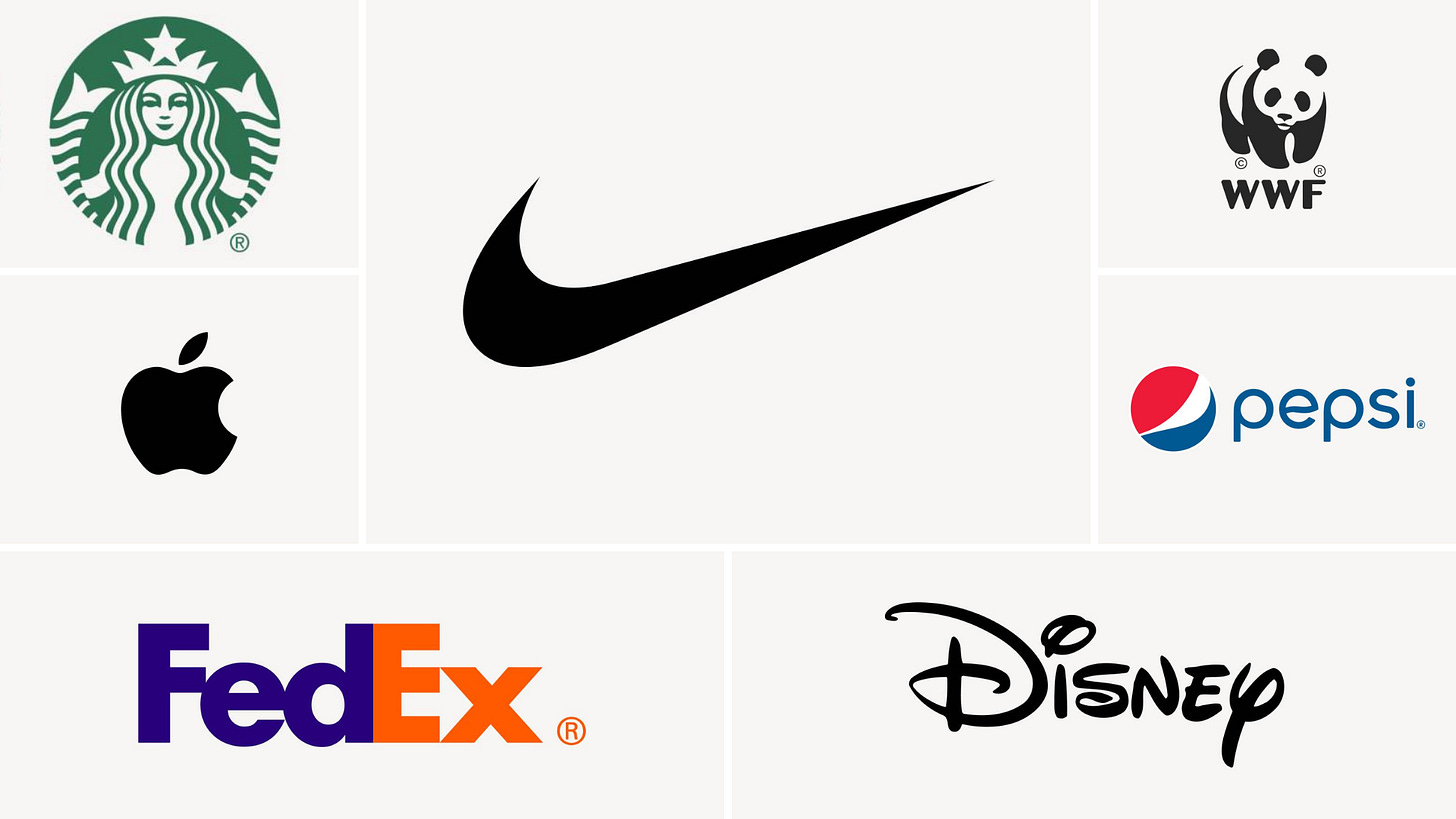By now, you’ve probably heard about Cracker Barrel’s logo fiasco. It’s hard to miss when a design tweak turns into a full-blown culture war.
Still, let’s hit rewind for a quick refresher:
In August 2025, Cracker Barrel unveiled a new, minimalist logo as part of a broader strategy to modernize under CEO Julie Felss Masino. The design replaced the beloved “Uncle Herschel,” a man leaning on a barrel, with a clean, text-only aesthetic using the same brown and gold palette.
The internet did not approve.
The response was swift and surprisingly intense. Longtime fans viewed the change as a betrayal of the brand’s history and charm.
The redesign became politicized when conservative figures, including Donald Trump Jr., Christopher Rufo, and even Trump himself, criticized it as unnecessarily "woke."
Financially, the rebrand backfired. Credit and debit transaction data showed a sharp drop in customer traffic between August 19 and 26. The restaurant chain also lost nearly $100 million in market value while facing intense backlash.
All of this over a simple logo change? Welcome to branding in 2025.
Many thinkpieces (paywalled) and words have already been written about this, but here’s the Pipitone Creative take – because there’s plenty to learn from this story.
When logos carry memories
Logos aren’t just graphics. They’re shorthand for memory, tradition, and trust, visual anchors that carry decades of associations in a single glance.
They live in the collective imagination, becoming inseparable from the experiences people attach to them.
For Cracker Barrel, “Uncle Herschel” embodied southern comfort, hospitality, and Americana, a visual promise of rocking chairs, cornbread, and a slower pace of life. Generations of customers saw him as a familiar face, a kind of cultural shorthand for warmth and continuity.
So when he was removed, it felt like a rupture. To many, it was as if the brand had walked away from its own identity, cutting ties with the very nostalgia that kept customers loyal. In branding, small visuals hold immense emotional weight. Take them away carelessly, and it can feel like taking away the soul of the brand itself.
Takeaway: Treat heritage elements with care. Before making bold changes, test with loyal customers. Don’t underestimate a brand’s emotional attachment.
If you don’t explain the change, your customers will
The new logo appeared without explanation.
To loyal customers, it landed as an unpleasant surprise. A change to something so familiar demands context, but none was offered. There was no clear vision or narrative explaining why the update mattered or how it connected to the brand’s future.
In the absence of a story, people created their own. And rarely are those stories good. Some assumed the brand was trying to distance itself from its roots.
Others suspected it was bending to political or cultural pressures.
What could have been framed as a natural evolution instead became a breeding ground for skepticism and even conspiracy.
If you don’t explain your choices, your audience will define them for you. And their version of the story may not be the one you want told.
Takeaway: Always lead with why. A brand refresh is a chance to share your future vision. Without context, even well-meaning changes look arbitrary.
Social media moves faster than you
The backlash was viral within hours. Cracker Barrel’s official responses lagged far behind, giving critics, comedians, and culture warriors the mic.
In today’s hyper-connected landscape, every minute of silence online is an open invitation for others to define your narrative.
Instead of leading the conversation, the brand was left playing defense.
By the time the corporate statements arrived, the memes, think-pieces, and outrage had already shaped public perception.
The lesson: a slow response isn’t neutral. It actively amplifies the voices against you.
Social platforms don’t wait for your press release. If you’re not ready with a plan, your brand will become the punchline before you even enter the room.
Takeaway: Build a rapid-response playbook. Monitor in real time. In the first 24 hours, silence looks like surrender.
Politics will find you
Donald Trump even jumped in (because of course he did), posting an AI-generated video of himself dancing with the “Uncle Herschel” after the logo reversal.
As ridiculous as the video was, it was further proof that brand decisions can instantly morph into national cultural flashpoints these days.
What started as a simple design tweak turned into full-blown political theater.
On today’s social platforms, nothing is too small to spark outrage.
And it’s not just household names like Cracker Barrel. Any brand, no matter how small, can find itself suddenly at the center of a viral storm.
We may wish that something as innocuous as a logo update wouldn’t ignite this kind of firestorm. But in today’s polarized environment, that’s the reality.
Takeaway: Expect politicization, especially if your brand carries nostalgia. Stay anchored in values-based language to avoid being dragged off course.
Internal disagreements, external damage
Tommy Lowe, the 93-year-old co-founder of Cracker Barrel, publicly criticized the rebrand as disrespectful to the chain’s heritage.
His remarks carried weight not only because of his age and legacy, but because they underscored what many loyal customers felt: that the company was abandoning its roots.
Once the co-founder himself blasted the logo, the controversy escalated.
What might have been framed as a design refresh quickly became a narrative of betrayal. Internal disagreement became a headline.
The story was no longer about a logo but about a brand at war with its own identity.
Adding fuel to the fire, branding experts piled on. Personalities like Jon Taffer mocked the decision, saying they “completely blew it.”
Marketing expert Jon Shapiro wrote in Restaurant Dive that, “If you don’t protect your brand’s core essence, you can turn your brand into a soulless 'bland.”
By removing such an iconic image, Shapiro and others argued, Cracker Barrel had stripped away the authenticity that made it special in the first place.
Instead of leading with a confident vision, the company suddenly looked unsure of who it was, leaving customers and critics alike to question its direction.
Takeaway: Before unveiling a new identity, make sure the entire organization, from leadership to front-line employees, understands and supports the shift.
Reversals aren’t fatal (if framed well)
Cracker Barrel’s quick U-turn calmed some outrage, but it also looked like panic.
What might have been framed as responsiveness instead came across as reactive damage control. To many, the reversal signaled that the company hadn’t thought the change through in the first place.
Facing pressure, Cracker Barrel reversed course just days later.
“Uncle Herschel” was restored to his rightful place. The company issued a statement thanking customers for their feedback and acknowledging the mistake.
The move quieted some critics and reassured longtime patrons who felt their traditions had been protected.
But the damage was done. The back-and-forth created the impression of a brand caught off balance, with no clear compass.
In an era where brand trust is fragile, inconsistency can be as damaging as the original misstep. Customers don’t just want to be heard, they want to believe a brand knows who it is and where it’s going.
Takeaway: If you reverse course, own it. Frame it as listening, not caving.
Balancing nostalgia & innovation
The mistake wasn’t necessarily modernization itself.
It was the decision to abandon heritage altogether. Brands evolve, but they must do so in a way that honors the emotional equity they’ve already built.


Customers don’t reject progress. They reject erasure.
A hybrid approach could have changed the entire narrative. Cracker Barrel might have kept the “Old Timer” in certain legacy contexts (on signage, packaging, or merchandise) while introducing a modernized design for digital platforms or new ventures.
This would have framed the update as an expansion, not a replacement.
By balancing old and new, the company could’ve invited customers into the story: “We’re keeping what you love, while also growing into the future.”
Instead, the abrupt swap made loyalists feel as if their memories and traditions were being discarded. In branding, heritage and innovation aren’t opposites; they’re partners. The strongest identities know how to carry both forward.
Takeaway: Brand evolution doesn’t have to be all or nothing. Small steps and test campaigns are safer than giant leaps.
Why branding drives everything
The Cracker Barrel logo fiasco was a stark reminder that branding decisions are never surface-level. What may look like a simple marketing move can carry real financial and operational consequences.
The controversy sparked online outrage, but it also translated into lost sales, a dip in stock value, and reputational damage.
Branding is the connective tissue of a business. It shapes how customers perceive you, how investors value you, and even how employees feel about working for you.
A misstep in brand identity can erode trust, spark boycotts, and leave a company scrambling to rebuild credibility.
The lesson is clear: branding isn’t decoration. It’s strategy.
Every logo, tagline, or campaign signals something about who you are and what you stand for. When those signals misfire, the ripple effects extend far beyond the marketing department and hit the bottom line.
Takeaway: Treat branding as a business decision, not just a marketing one. It’s the company’s heartbeat. When you change it, expect the whole body to feel it.
Keep your brand alive & authentic
The Cracker Barrel logo drama proves a simple branding and marketing truth: people don’t just buy food, products, or services.
They buy stories, too. They buy what feels familiar, authentic, and alive.
A brand isn’t a coat of paint. It’s the heartbeat of a company. And when that heartbeat falters, everyone notices.
At Pipitone Creative, we help brands modernize without flatlining. If your identity feels stuck between honoring tradition and embracing the future, think of us as your brand cardiologists, here to keep your story strong, steady, and beating.
Ready to turn your story into your strongest strategy? Let’s talk.





